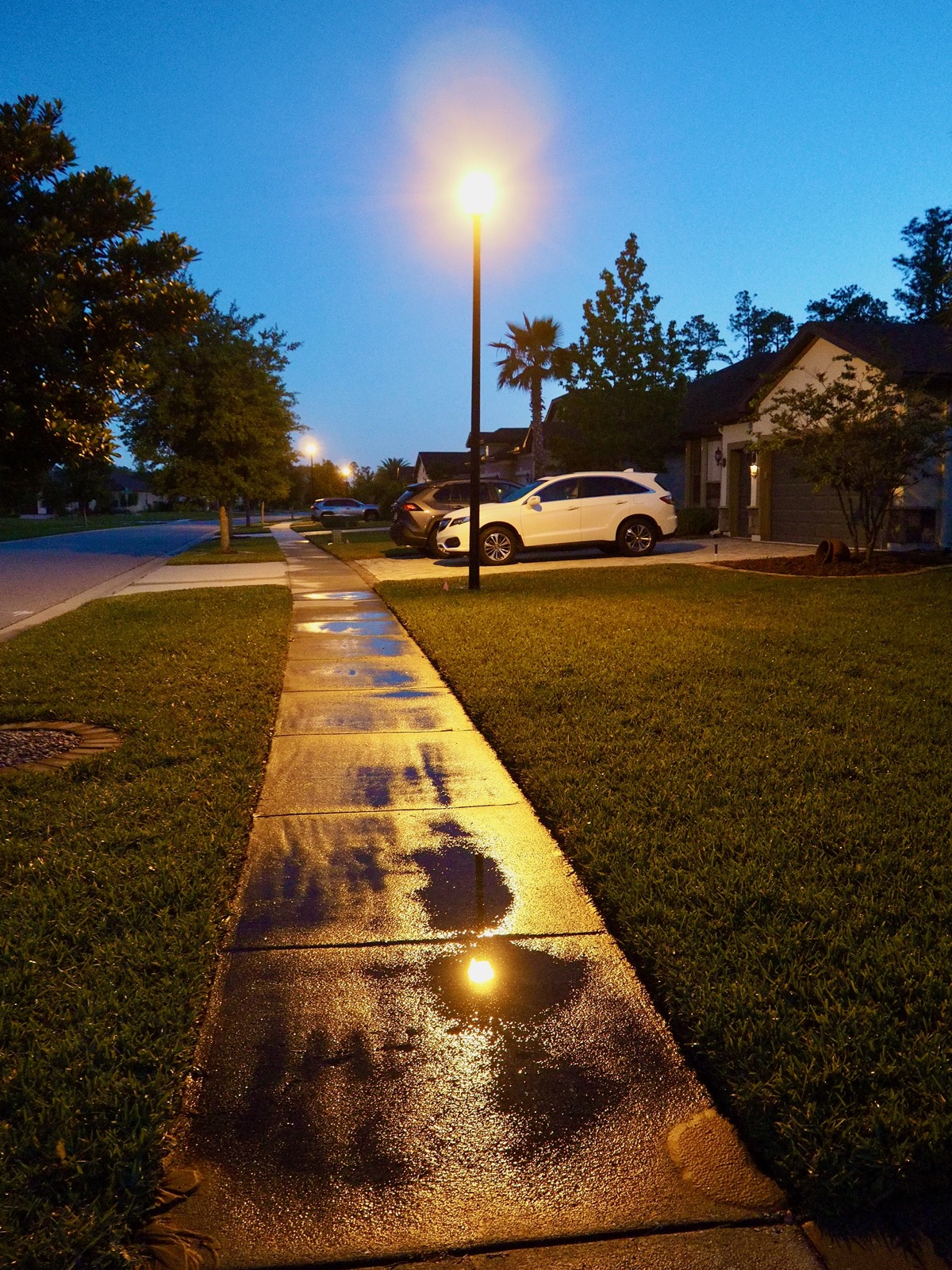
Mitzi headed off to San Diego this morning, and I went out for my walk. This is a nothing shot, but just for grins I shot the street lamp reflection in the puddle. The only reason I'm sharing it is because I sat in on a portion of a 1000 Friends of Florida webinar about smarter development in Florida where we hope to maintain a wildlife corridor. One of the slides showed a neighborhood of stucco homes that looked identical to my neighborhood (Quelle surprise.) and the presenter commented that it looks more like a habitat for cars than for people, and that resonated with me.
So, that's why this pic in this post. Not much of a reason, but my blog, my rules.
Anyway, the second Nebo solar panel and additional cables didn't arrive until after sunset yesterday evening, so I haven't played around with them yet. That's next on the agenda today.
My battery obsession continues. I watched a couple of videos by a guy whose channel is called Hobotech. I haven't watched enough of his videos to form any opinions about the guy. The appearance of a handgun in one gave me pause, but I remain ambivalent for now.
He does have decent production values, and the design of his tests and the quality of his information seems good. I watched this review of the Bluetti AC70 and AC2A and thought he did a thorough review. I recommend watching these videos a 1.5x speed, you can always pause and back up if you want to hear something again. YouTube surfaced another of his videos that I wasn't directly searching for, comparing Li-ion rechargeable AA batteries with NiMHs. I thought that was well done, surprising and worthwhile.
If you're disinclined to watch it, suffice to say NiMHs are likely the best value in AA battery solutions by quite a lot. Their single biggest limitation is their 1.2v discharge voltage, which is going to give you "low battery" alerts early, but which will be misleading because your device will continue to run for a long time at that voltage. If you have something that requires 1.5v, like an external flash, then lithium or conventional alkaline disposables are probably a better choice. But in terms of a "sustainable" AA battery, NiMH is the winning chemistry.
I'm also pleased with my choice of the Bluetti EB3A paired with the AC70. I think they complement each other in terms of features, at a reasonable price point. I'm unsure if the EB3A will be on the market for much longer, as the AC2A appears to have replaced it. If the EB3A isn't available, the AC2A is a worthwhile substitute, albeit more limited.
In an era of frequent extreme weather events and potential power outages, I think it's worthwhile to have something more substantial than a package of AAs from the grocery store and a USB power brick in your emergency kit. Something like the EB3A and the AC70 give you significantly more options in terms of powering devices that might be useful in an emergency. They're also small and light enough that they're easy to put in your car if you can't stay in your home for whatever reason.
Similarly, having a modest solar recharge capability just makes sense. You can go crazy on portable panels, but the expense and weight and handling issues go up quickly. A single 200W panel or a couple of 100W panels are probably sufficient unless you're looking to embark on serious van camping or something.
Some rechargeable NiMH AA and AAA batteries and a charger would also be useful for radios and portable lights.
This kind of preparation anticipates that a power outage might last from a few hours to a few days. Anything longer than that and it's kind of in another regime where you may not wish to live there until power and utilities are fully restored.
Preparing a home to be habitable in a situation where power, water and sewer are unavailable for long periods of time is a far different problem. I think we're in good shape here on the power front, but I don't have a good answer for water and sewer. A 5-gallon bucket and sawdust seems to be the go-to solution, but where do you get sawdust from?
In the near term, say the next 5 to 10 years, I think temporary disruptions might be what we're most likely to experience. I think it becomes more uncertain after that. But we do have some time think about it.
Originally posted at Nice Marmot 09:33 Saturday, 13 April 2024